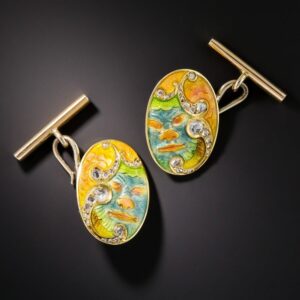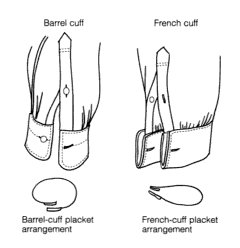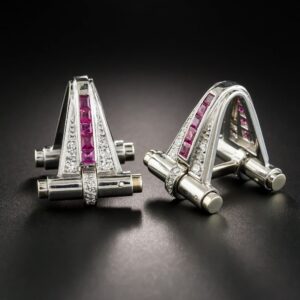
Cuff links are decorative double-button devices used to connect the sides of a shirt cuff. The buttons can be connected with bars or chains or may be one-sided with a levered mechanism.
Historically men have worn shirts as a sort of protective garment to provide a buffer between the skin and outer clothing. Following the Middle Ages shirts began to take on decorative features such as ruffles and fancy embroidery. Ruffles at the edge of sleeves eventually morphed into shirt cuffs. These cuffs or wristbands were often tied closed by the use of a thread or ribbon. As men adopted fancy buttons on their coats and shirt fronts they came to the realization that they could also display these fancy buttons on their shirt sleeves. Gradually pairs of these buttons linked together began to appear on shirt cuffs. Referred to as sleeve buttons or in French as bouton de manchette they didn’t catch on immediately but evolved gradually as the wrist ruffles disappeared near the conclusion of the eighteenth century.

Eighteenth-century sleeve buttons reflected the jewelry styles of the times. Painted portrait miniatures, paste gems, cut crystals, and other signature Georgian styles turned up as sleeve buttons. Somewhere around 1850 the modern shirt cuff, similar to the ones still in fashion today, came into being. A three-inch band of cloth, give or take an inch, was attached to the end of the sleeve and fastened with a button or pair of sleeve buttons, sometimes referred to as a barrel cuff. French cuffs – the cuff folded double – also made their appearance at this time. These cuffs and collars were generally starched and very stiff. Searching for a closure that could be inserted easily into these overly stiff cuffs, chain link fasteners became the solution. These link fasteners were popularly known as cuff links. Other variations such as the dumbbell and the lever back cuff link were also popular.
The overall mechanization of the jewelry business provided the opportunity to mass produce cuff links creating a market for them at all socio-economic levels. From that point on cuff links were worn by everyone regardless of status or sex. Women adopted the style with a vengeance. Worn not only by women in the workplace but by gentlewomen of leisure as well. This was a time when fashion trends spread quickly both through the print media as well as by the now very mobile traveling public and cuff links were no exception.

Cuff Links can be found in every style and every jewelry period from Georgian through contemporary. Victorian men were very conservative in their choice of cuff links, wearing precious stones sparingly and only on very formal occasions. Arts & Crafts, Art Nouveau and Edwardian cuff links mirrored the aesthetic of the period. By the Edwardian period, the taboo on precious stones in men’s cuff links was lifted and formal attire was ablaze with gemstones. The post-war Art Deco period fashion was alive with glittering precious stones set into all manner of cuff links alongside sporting motifs and other whimsical designs. At the same time, the relaxation in formal dress with more casual, less starched clothes for day wear began a trend for plain sewn-on buttons for shirt cuffs and relegated the fancy cuff links to evening wear. The Depression and World War II diminished the fashion further. Following the war cuff links in more tailored styles enjoyed a resurgence until the 1960s when casual attire once again quashed the need for cuff links. While still available today, and fashionable for evening wear, cuff links have never again reached the level of desirability that they enjoyed at the turn of the twentieth century.
Sources
- Gere, Charlotte and Rudoe, Judy. Jewellery in the Age of Queen Victoria: A Mirror to the World: London, The British Museum Press, 2010.
- Jonas, Susan and Nissenson, Marilyn. Cuff Links. New York, NY, Harry N. Abrams, Inc., 1991.